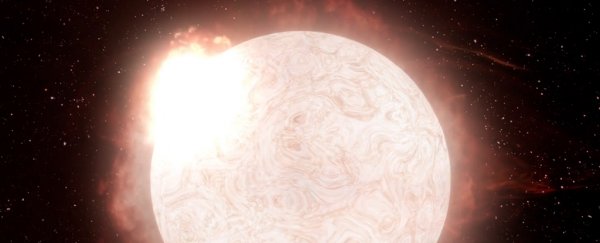We're seeing many spectacular sights out in space as our telescopes become more powerful, but there's a new contender for the most exciting one yet: According to researchers, we've observed a red supergiant star exploding into a supernova for the first time.
Supernova (SN) 2020tlf, to give it its technical name, was watched for 130 days leading up to the gigantic blast, the result of the demise of a star some 120 million light-years away from Earth in the NGC 5731 galaxy and about 10 times more massive than our own Sun.
The team says that this unprecedented look at one of the most fascinating and large-scale events in the Universe shows that there isn't always a 'calm before the storm' in terms of supernova blasts – something that challenges previous assumptions.
"This is a breakthrough in our understanding of what massive stars do moments before they die," says Wynn Jacobson-Galán, an astronomer from the University of California, Berkeley, and the study's lead author.
"Direct detection of pre-supernova activity in a red supergiant star has never been observed before in an ordinary Type II supernova. For the first time, we watched a red supergiant star explode!"
Supernovas happen when massive stars die, or run out of fuel and collapse in on themselves, no longer to keep the forces of gravity and nuclear reactions in balance. A giant, super-bright explosion follows the collapse, sending shock waves through space, and usually leaving a dense core surrounded by a cloud of gas called a nebula.
This dramatic process has never been seen in real time before, though. Two telescopes were involved in making the observations, both on Hawaii: the University of Hawaii Institute for Astronomy Pan-STARRS on Haleakalā, Maui, and the WM Keck Observatory on Mauna Kea, Hawaii Island.
The collected data is already providing new insights. There was direct evidence of dense circumstellar material surrounding the star when it exploded, for example, which the researchers think was the same gas they had spotted being ejected from the red supergiant several months before.
"It's like watching a ticking time bomb," says astrophysicist Raffaella Margutti, also from UC Berkeley. "We've never confirmed such violent activity in a dying red supergiant star where we see it produce such a luminous emission, then collapse and combust, until now."
Based on the observations, it seems as though at least some red supergiants undergo significant internal changes before transforming into supernovas – possibly instabilities linked to the final stages of nuclear fuel burning – creating the violent eruptions and luminosity observed in this case.
The high level of radiated light alerted astronomers to this particular star in the first place. The supernova was monitored after the explosion, too, for another 300 days, giving astronomers even more data to work with.
The observations were made as part of the Young Supernova Experiment, an ongoing project attempting to find stellar explosions in the night sky in their very earliest stages. With the new information now available to them, it should be easier to spot supernova events before they happen.
"I am most excited by all of the new unknowns that have been unlocked by this discovery," says Jacobson-Galán. "Detecting more events like SN 2020tlf will dramatically impact how we define the final months of stellar evolution, uniting observers and theorists in the quest to solve the mystery on how massive stars spend the final moments of their lives."
The research has been published in the Astrophysical Journal.
